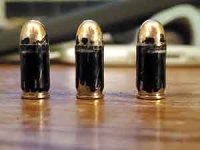Need some help here. My first batch of 380 I made just 10 rounds. Only 4 of them passed the chamber checker. I tried adjusting the factory crimp die which improved things a bit. I'm using the Lee 4 die set and Challenger press. But some rounds are rough going in and none of the 6 drop out on their own. The plunk test in the barrel showed all 10 go in fine but the same 6 do not drop out on their own.
I used Berry's 100 grain plated bullets. 3.0 gr of Universal, Win SP primers and mixed once fired brass from my lgs.
At first I thought something was up with the bullets. I noticed some resistance on seating on several of them. Maybe that caused it, maybe they didn't go in strait.
I measured 10 more of the berry's bullets with calipers and find the diam .3545 and length to all be within 1/2 of 1000 of each other. I have not extracted the bullets from those rounds yet.
The finished bullets measured the same way, very close at the head as well as the neck. I did have to adjust the seating die several times to get the same COL .982 is what I was going for. And I had to reset the Factory Crimp Die for all the 6 rounds with little improvement.
Then I started to suspect it was the brass being of mixed types. But the results don't indicate that. It's basically the same mix between the good rounds and those that don't drop. Win, CBC Aquila, OBC, HRTRS and Speer.
I was going to at least fire the 4 that passed, and maybe try and see if the 6 bad ones cause FTF or FTE.
Any thoughts?
Maybe I should just buy some fresh never fired brass.
Did I wast $70 on Berry's Bullets?
Is it my technique?
Wrong brand of Die's?
Thanks,
I used Berry's 100 grain plated bullets. 3.0 gr of Universal, Win SP primers and mixed once fired brass from my lgs.
At first I thought something was up with the bullets. I noticed some resistance on seating on several of them. Maybe that caused it, maybe they didn't go in strait.
I measured 10 more of the berry's bullets with calipers and find the diam .3545 and length to all be within 1/2 of 1000 of each other. I have not extracted the bullets from those rounds yet.
The finished bullets measured the same way, very close at the head as well as the neck. I did have to adjust the seating die several times to get the same COL .982 is what I was going for. And I had to reset the Factory Crimp Die for all the 6 rounds with little improvement.
Then I started to suspect it was the brass being of mixed types. But the results don't indicate that. It's basically the same mix between the good rounds and those that don't drop. Win, CBC Aquila, OBC, HRTRS and Speer.
I was going to at least fire the 4 that passed, and maybe try and see if the 6 bad ones cause FTF or FTE.
Any thoughts?
Maybe I should just buy some fresh never fired brass.
Did I wast $70 on Berry's Bullets?
Is it my technique?
Wrong brand of Die's?
Thanks,

